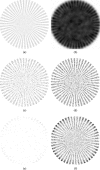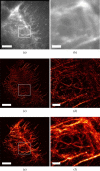Simultaneous multiple-emitter fitting for single molecule super-resolution imaging
- PMID: 21559149
- PMCID: PMC3087594
- DOI: 10.1364/BOE.2.001377
Simultaneous multiple-emitter fitting for single molecule super-resolution imaging
Abstract
Single molecule localization based super-resolution imaging techniques require repeated localization of many single emitters. We describe a method that uses the maximum likelihood estimator to localize multiple emitters simultaneously within a single, two-dimensional fitting sub-region, yielding an order of magnitude improvement in the tolerance of the analysis routine with regards to the single-frame active emitter density. Multiple-emitter fitting enables the overall performance of single-molecule super-resolution to be improved in one or more of several metrics that result in higher single-frame density of localized active emitters. For speed, the algorithm is implemented on Graphics Processing Unit (GPU) architecture, resulting in analysis times on the order of minutes. We show the performance of multiple emitter fitting as a function of the single-frame active emitter density. We describe the details of the algorithm that allow robust fitting, the details of the GPU implementation, and the other imaging processing steps required for the analysis of data sets.
Keywords: (100.3010) Image reconstruction techniques; (100.6640) Superresolution; (180.2520) Fluorescence microscopy.
Figures







References
Grants and funding
LinkOut - more resources
Full Text Sources
Other Literature Sources
